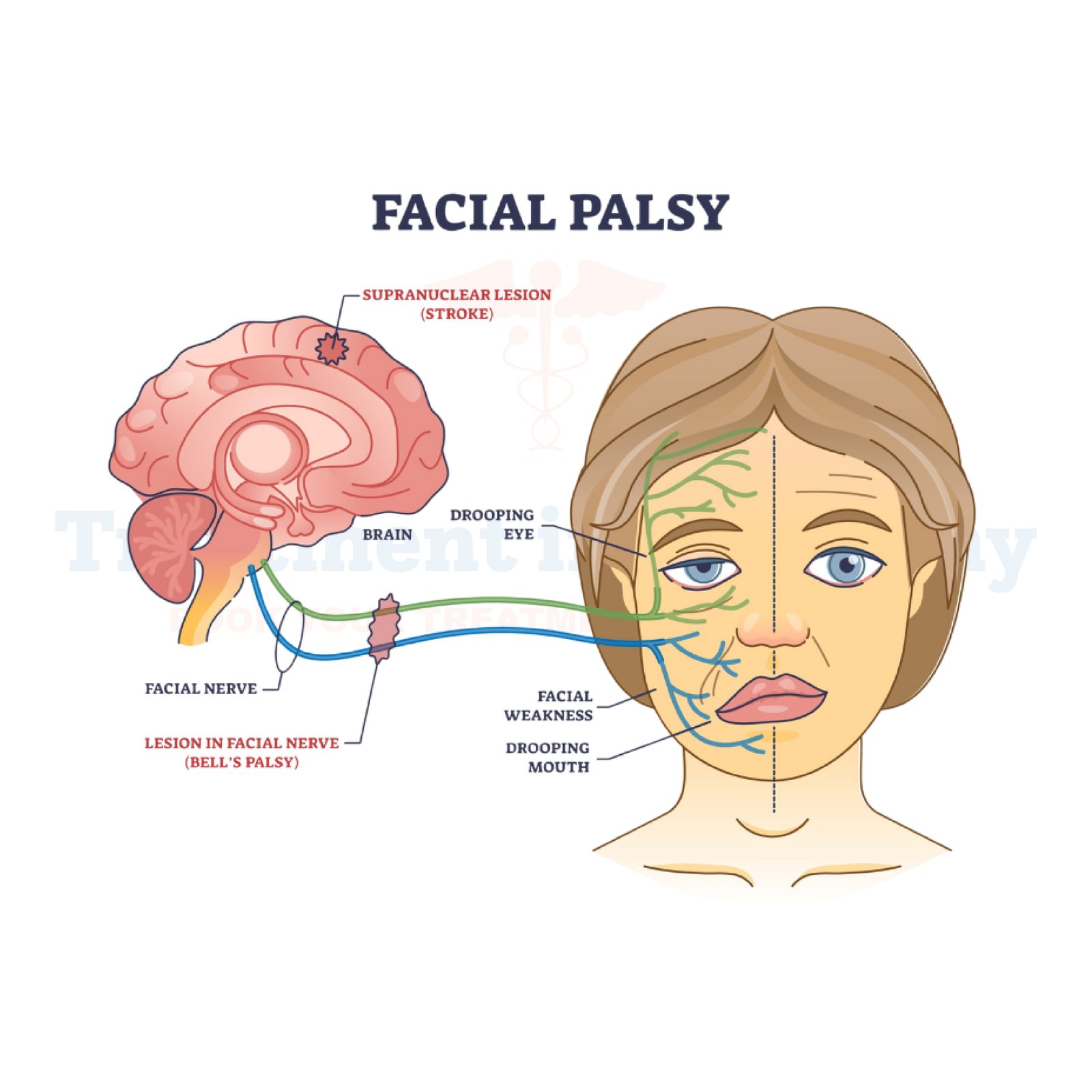Bell's palsy is a sudden, temporary paralysis or weakness of the muscles on one side of the face, often causing drooping or difficulty with facial expressions. This condition occurs when the facial nerve (cranial nerve VII) becomes inflamed, swollen, or compressed. While the exact cause of Bell’s palsy is unknown, it is often linked to viral infections or underlying health conditions.
Germany is recognized globally for its innovative treatments and comprehensive care for neurological conditions like Bell’s palsy. From advanced diagnostic tools such as MRI (Magnetic Resonance Imaging) and CT (Computed Tomography) scans to highly specialized therapies, Germany provides world-class care for patients from all over the world.
Although the exact cause remains unclear, Bell’s palsy is often associated with:
Viral Infections:
Herpes simplex virus (HSV), which causes cold sores.
Varicella-zoster virus (responsible for chickenpox and shingles).
Epstein-Barr virus (mononucleosis).
Autoimmune Diseases:
Inflammation triggered by immune system disorders.
Diabetes:
People with diabetes have a higher risk of nerve inflammation.
High Blood Pressure (Hypertension):
Can contribute to nerve damage or compression.
Risk Factors for Bell’s palsy
The following factors increase the likelihood of developing Bell’s palsy:
Age:
Most common between ages 15 and 60.
Pregnancy:
Especially in the third trimester or postpartum period.
Chronic Health Conditions:
Obesity, diabetes, and autoimmune diseases can heighten the risk.
Family History:
A genetic predisposition may exist in some cases.
Symptoms of Bell's palsy
The symptoms of Bell's palsy can range from mild to severe and typically appear suddenly. Common symptoms include:
Diagnosis and Diagnostic Tools for Bell’s palsy
In Germany, hospitals and specialists use advanced diagnostic methods to accurately identify Bell’s palsy and rule out other conditions like strokes or tumors.
Diagnostic Steps:
Physical Examination:
Evaluates facial muscle strength, coordination, and reflexes.
Imaging Tests:
MRI (Magnetic Resonance Imaging):
Helps detect inflammation of the facial nerve or other abnormalities.
CT (Computed Tomography) Scan:
Identifies structural issues like tumors or fractures.
Electromyography (EMG):
Measures nerve activity and evaluates the extent of nerve damage.
Blood Tests:
Rules out infections, autoimmune conditions, or underlying health issues like diabetes.
Hearing and Balance Tests:
Checks for issues related to the inner ear, which may mimic Bell's Palsy symptoms.
Treatment Options for Bell's palsy in Germany
Germany offers some of the most innovative treatments for Bell’s Palsy, combining traditional medical approaches with cutting-edge therapies. The treatment focuses on reducing inflammation, improving nerve function, and restoring facial muscle strength.
Medications:
Corticosteroids:
Reduce inflammation and swelling of the facial nerve.
Antiviral Drugs:
Prescribed if a viral infection is suspected (e.g., herpes simplex).
Pain Relievers:
Alleviate facial pain and discomfort.
Physical and Complementary Therapies:
Physical Therapy:
Exercises to strengthen facial muscles and improve coordination.
Facial Massage:
Promotes blood flow and muscle relaxation.
Acupuncture:
A complementary therapy used to stimulate nerve recovery.
Advanced Therapies in Germany:
Electrical Stimulation:
Non-invasive treatment to stimulate nerve regeneration.
Botulinum Toxin (Botox) Therapy:
Used to manage facial muscle spasms or asymmetry.
Stem Cell Therapy:
A promising regenerative approach to repairing nerve damage.
Surgical Options:
In rare cases, surgery may be necessary to relieve pressure on the facial nerve. German hospitals use minimally invasive techniques to ensure better outcomes and faster recovery.
Why Choose Treatment for Bell's palsy in Germany?
Germany has earned its reputation as a leading destination for neurological treatment due to its exceptional medical infrastructure, skilled specialists, and patient-centered care. Here’s why patients from around the world choose Germany:
Renowned Specialists:
Germany boasts some of the best neurologists and surgeons with expertise in facial nerve disorders.
Innovative Treatment Approaches:
Access to cutting-edge therapies like stem cell therapy and advanced physical rehabilitation techniques.
State-of-the-Art Hospitals:
Equipped with advanced imaging technologies such as MRI and CT scans.
Comprehensive Care Plans:
Multidisciplinary teams addressing both physical and emotional aspects of recovery.
Affordable Healthcare:
High-quality care at a fraction of the cost compared to similar standards in other countries.
Managing Bell’s palsy: Solutions and Strategies
While Bell’s palsy is usually self-limiting, proactive management can speed up recovery and minimize complications:
Early Diagnosis:
Seek medical attention immediately if you notice facial weakness or drooping.
Consistent Therapy:
Engage in daily facial exercises and attend regular physical therapy sessions.
Healthy Lifestyle Choices:
Maintain a balanced diet, stay hydrated, and manage conditions like diabetes and obesity.
Stress Management:
Stress can exacerbate symptoms; relaxation techniques like yoga or meditation can be beneficial.
Regular Monitoring:
Regular follow-ups ensure that treatment plans remain effective.
Conclusion
Bell’s palsy is a challenging but manageable condition that can significantly impact an individual’s daily life. Germany’s advanced diagnostic tools, world-class specialists, and cutting-edge therapies make it an ideal destination for Bell’s palsy treatment. Whether through medication, physical therapy, or innovative approaches like stem cell therapy, Germany offers comprehensive solutions to help patients regain their confidence and quality of life.
By opting for treatment in Germany, patients can access exceptional care tailored to their unique needs, ensuring a faster and more effective recovery.
👉 Contact us for further information and receive a complimentary consultation.

.webp)
.webp)
 (1).webp)
 (1).webp)


.webp)
.webp)
 (1).webp)
 (1).webp)

